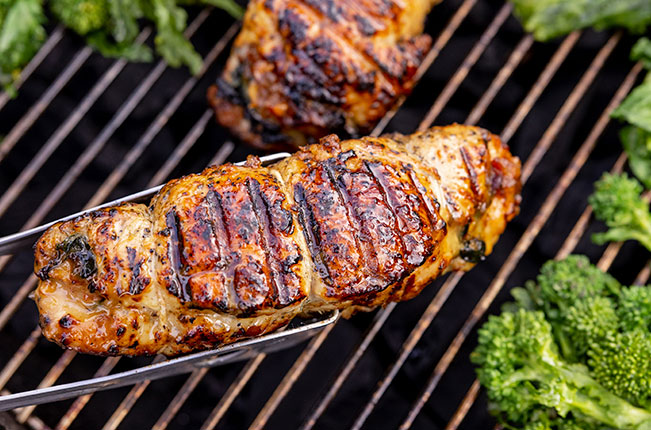
How to grill turkey
Everything you need to know about how to make moist and tasty grilled turkey is right here, starting with how to prepare your turkey for the grill.
In most American homes, turkey and stuffing are the stars of Thanksgiving, Christmas, and Easter dinners. But, you don’t need to wait for the holidays to have delicious grilled turkey!
In this article, we’ll teach you how to grill a whole turkey the right way. You can also take these techniques to grill your favorite cuts of turkey, like bone-in turkey breast, turkey tenderloin, or even ground turkey. Check out the recipes at the bottom of this article to get cooking.
Prepare Your Turkey
Cooking a frozen turkey will lead to a longer cook time and dry meat. Avoid such issues by thawing your turkey before cooking it. The fastest way to thaw your turkey is to put it in a leak-proof bag and submerge it in cold water. We recommend keeping the turkey in the bag it came in and changing the cold water every 30 min. You may also thaw your turkey in the refrigerator. Check your packaging or see here for details on thawing.
After the turkey has thawed, remove the giblets and neck from inside the turkey cavity, then follow these prep steps:
Prepare the Grill
Every grill comes with its own set of instructions regarding preparations for grilling turkey. Follow all the instructions provided by your grill manufacturer to ensure that the grill is clean and hot enough for your whole bird.
Dry and Oil the Turkey
Pat the turkey dry with a paper towel, then rub cooking or vegetable oil on the body and insides. Fold the wings behind the turkey to make the neck skin taut and tuck the legs before seasoning.
Season the Turkey
The oil you previously applied will help your dry seasoning adhere to the turkey’s body. Your options for seasoning include:
- Dry Brine: Dry brining locks moisture and flavor into the turkey so that it comes out moist and tasty after grilling. It also gives your turkey crispy, tasty skin. The process involves creating a powdered dry brine mixture of salt, black pepper, and any other seasonings you want. Coat the bird with the seasoning and let it cure in the fridge for at least two hours. However, if you want the moistest turkey, let it brine for 12 to 24 hours.
- Mopping: Mopping your turkey with a seasoned sauce will keep the bird moist during grilling. You can make your own mop sauce or buy an already prepared sauce at the store. You will need a barbecue mop or brush to apply the sauce to the turkey as it cooks. Achieve maximum moistness and flavor by mopping on the sauce every hour while grilling the turkey.
Speed Up the Cooking Process with Spatchcocking
Spatchcocking involves butterflying your whole turkey and removing the backbone. Doing this opens up the bird so that you can thoroughly season it and cook it evenly. Another benefit of spatchcocking your turkey is reducing the grilling time by up to 90 minutes.
Within an hour, the open breast meat can reach an internal temperature of 165°F while the dark meat reaches 190°F. The shortened cooking time helps reduce the likelihood of overcooking and drying out the white meat.
Choose Your Grill
Several grill types are available for grilling turkey, including electric, charcoal, and gas grills. Charcoal and gas grills are the most popular because they can reach higher temperatures to sear your turkey and lock in the flavor.
However, charcoal grills can reach higher temperatures than gas grills and cost less to buy and install. Also, charcoal grills give your grilled turkey a unique smoky flavor that gas grills can’t deliver. Lastly, charcoal grills are more portable, and you don’t have to worry about gas leak dangers.
On the other hand, gas grills are easier to use and provide more temperature control. Unlike charcoal grills, you don’t have to wait 15 to 30 minutes for a gas grill to get hot. Gas grills are typically easier to clean as well.
How to Grill a Turkey on a Charcoal Grill
If you prefer working with a charcoal grill, here’s how to grill a whole turkey on it:
- Before lighting the grill, wipe the grates clean with a cloth, then season or spray the grates with high-heat cooking oil (canola or peanut oil). Wipe off any excess oil. Seasoning the grill will help stop your turkey from sticking to the grates and give you neat, beautiful sear marks.
- Remove the main cooking grate, pour in your charcoal briquettes, and light them.
- After the charcoal has burned for about 30 minutes, push the coals to one side of your grill. Put a drip pan on the side without coals.
- Put the cooking grate back on and place your turkey, breast side up, on the grates over the drip pan. The drip pan will catch oils dripping from the turkey and prevent flames that may burn the bird.
- Cover the grill and leave the vents open.
- Every 60 minutes, check on your turkey and add eight to nine briquettes to the burning charcoal to maintain a grill temperature of 325°F.
- A 10 to 18-pound bird should take about two to three hours to cook. After the two-hour mark, insert a meat thermometer inside the turkey breast to see if it has reached an internal temperature of at least 165°F as shown on a meat thermometer.
- Once the turkey reaches a 165°F internal temperature, take it off the grill and let it rest for at least 15 minutes before carving.
How to Grill a Turkey on a Gas Grill
If you have a gas grill, here’s how to grill a whole turkey with it:
- Season the grill grates (same as in Step 1 for a charcoal grill).
- Light all the burners and preheat the gas grill to 350°F.
- Once the grill is hot, turn off the burners on one side of your grill.
- Place the turkey in a roasting pan with the breast facing upwards. Cook your turkey with indirect heat by putting the roasting pan on the unlit side of the grill. Half way through the cooking process you may flip the turkey over.
- Close the grill’s lid and wait for two to three hours before checking the internal temperature of the turkey breast with a meat thermometer. If it’s at least 165°F, your turkey is ready.
- Let your grilled turkey rest for at least 15 minutes before carving.
Direct Heat vs. Indirect Heat
Indirect heat is best for roasting a whole turkey or any cuts that still have the bones inside – like, bone-in turkey breast. That’s because indirect heat cooks meat slowly and evenly, preventing the bird from drying out.
Grilling over direct heat for two to three hours may burn or over-char your turkey. However, if you are cooking a lean cut of meat that can cook within minutes, it’s okay to use direct heat.
Ready for More Grilled Turkey Recipes?
There’s more than one way to grill a turkey. Put a tasty twist on traditional grilled turkey by trying one of these yummy recipes.
Whole Turkey
Turkey Tenderloin
- Grilled Marinated Turkey Tenderloins
- Stuffed & Grilled Rotisserie Turkey Tenderloins
- Marinated Grilled Turkey Kabobs With Grilled Vegetable Skewers
Ground Turkey
Grilled Turkey FAQs
Start grilling your turkey with the breast facing upwards. Halfway into the cook, flip the turkey over. Using appropriate hand protection, such as oven mitts, grasp the turkey at its neck and tail and carefully flip it, being mindful of hot juices. Doing this is necessary for an even cook and a turkey beautifully browned on all sides.
A grilled turkey is ready when the breast’s internal temperature is at least 165°F.
It will take two to three hours to grill a 10 to 18-pound turkey with indirect heating.
Hungry for More?
Sign up to get exclusive coupons, recipes, and seasonal inspiration straight to your inbox.
Join Now-
Products
It is our mission to provide you the highest quality turkey products to create and share wholesome meals with the ones you love.
Learn More -
Recipes
Thanks to turkey’s lean protein, you know you’re eating a meal you can feel good about. Dig in to find a new favorite for you and your family.
Learn More
